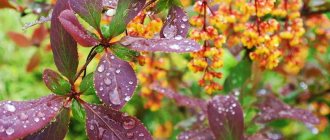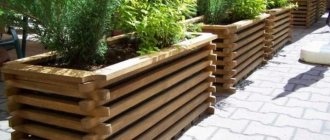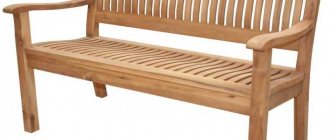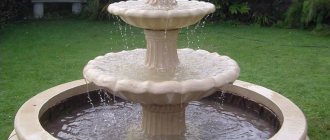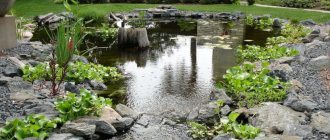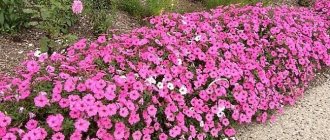general characteristics
It has long been believed that the daylily bush brings joy and good luck to the house. Indeed, looking at the catchy inflorescences instantly lifts your mood. It is also called a culture for the lazy. First of all, because of the basic conditions of detention.
The plant has flowers of a wide variety of shades. It blooms most actively in April-May, reaching June. The culture grows well in light shade and in areas of active sunlight. Adapted to natural disasters.
The lush color of daylily will not leave you indifferent!
The most popular daylilies in the garden
After highlighting all the most popular varieties, we will learn about their advantages, and also look at photos, with the help of which you can choose the most optimal variety for the season.
The most popular are varieties from groups of double and simple inflorescences.
An ordinary flower consists of 3 flowers, it also has 3 sepals and 6 stamens, one pistil. This group is distinguished by the shape of the flower.
Namely, in such forms as:
- Round;
- Flat;
- Informal;
- Reversed;
- Star-shaped;
- Triangular;
- Tubular.
In less warm climates, a variety of arachnid flowering, daylily spander, has proven itself. It brings color to everyday life as it blooms for a long time even in rainy weather. Such plants have an unusual inflorescence shape, which creates bright spots among other flowers. Such a plant is exotic in a flower garden, since the petals can be curved, twisted, and others.
Popular types
There are 70 thousand varieties, describing each of them is a difficult and routine task. Therefore, we suggest focusing on the most popular varieties. To begin with, a general classification according to the following parameters:
- Growing season. Some flower stalks are dormant, others are semi-green or even evergreen.
- Chromosomes (diplo-, tetraploid)
- Smell (smells very bright and has virtually no odor)
- Form. They can be spider-like, terry, and so on.
- Coloring. Eleven groups.
- Flowering time. There are early, late and even re-blooming ones.
Bonanza
Daylily Bonanza with yellow flowers, inside of which there is red pollination. It blooms regularly and is highly resistant to frost.

Variety Bonanza
Longfields Pearl
The highlight of this variety is that it is very similar to gladiolus. Longfields daylily blooms in August, the flowers are a delicate cream color. They will delight you with their incomparable appearance until October. The corolla reaches 10 centimeters in diameter.

Variety Longfields Pearl
Stella De Oro
Daylily Stella reaches 40 centimeters in height. It blooms for a long time, recommended for planting near borders and paths. Daylily with the exotic name Stella De Oro will become a real decoration of any garden.
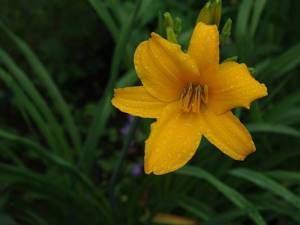
Variety Stella De Oro
Frans Hals
Another successful hybrid with a height of 60 to 80 centimeters. Daylily France differs from its counterparts in having wavy corollas. Daylily hybrid Frans Hals is colored in yellow and orange shades.
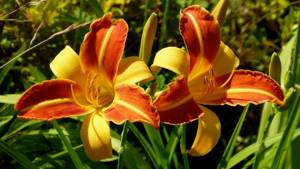
Variety Frans Hals
Hemerocallis flava
Daylily has the Latin name Hemerocallis. But if it is a yellow daylily, the prefix flava is added to it. The name speaks for itself - the corollas are yellow, hanging to the ground.

Variety Hemerocallis
Catherine Woodbury
Recently developed varieties include daylily Katerina. You can recognize it by its classic petals and lilac hue. Depending on the nature of the incidence of sunlight, it may vary. For example, under bright lighting, the daylily with the female name Katherine Woodbury takes on a pink tint. Diameter - at least 12 centimeters.

Variety Catherine Woodbery
Night Beacon
Night daylily has relatively small flowers - 8 cm. The core is yellow-green, but Knight Bacon daylily has purple petals.
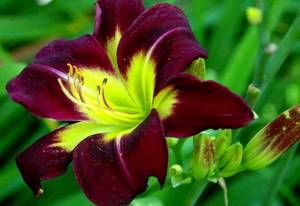
Variety Night Beacon
Double
Daylily Double is notable for its double corollas. The highlight is the rich yellow, almost lemon color.
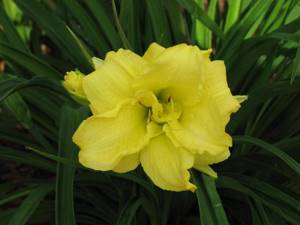
Variety Double Cutie
Pardon me
Daylily Pardon, whose name translates as “Excuse me,” is considered one of the shortest. Flowering begins in June and lasts until September. The hint of lime inside is the highlight of Pardon Mee daylily. No less attractive are the cherry-colored petals.

Pardon Me variety
Night Embers
Another bright representative with flowers decorated with terry corollas. Daylily Night has petals that seem to be covered with velvet, very pleasant to the touch.

Variety Night Embers
Lacy Doily
Lacy daylily grows up to 80 cm. The color is as delicate as the name - pale pink, and the shape of the petals is terry. There is also Pink daylily, which is also pink.
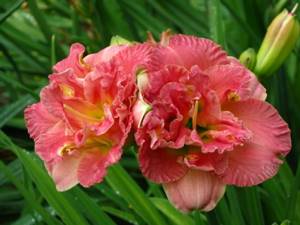
Variety Lacy Doily
Red Rum
A true gardener's dream is Daylily Red. Huge scarlet inflorescences reach ten centimeters in diameter. They bloom for quite a long time - almost all summer. The red daylily is not afraid of the sun at all.
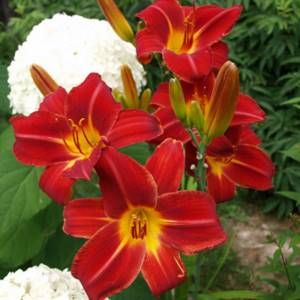
Red Rum variety
Black Stockings
It is considered a new product, as it was introduced only 3 years ago. The corolla is impressive - almost 15 centimeters! Black daylily is noticeable from afar due to its purple petals and yellow core. The edge is corrugated.

Variety Black Stockings
Anna Rosa
Also known as Anna Little daylily. “Annushka” is very miniature - only 40 centimeters, the corolla reaches 8 cm. Two waves of flowering, soft pink petals.

Variety Anna Rosa
Siloam
Daylily Double Siloam is an incredibly popular variety. The flowers are dense, double, cream-colored and attractively ruffled.

Variety Siloam
Spider
And we continue our fascinating journey into the world of plants. The Spider daylily group combines several varieties of perennial flowers that are popular among gardeners. The association with the spider explains the name of the flower. Its petals are too elongated and curved, reminiscent of the legs of an arthropod.
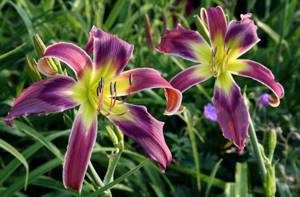
Variety Spider
Chicago
Velvet petals are the hallmark of the plant. The bright red color and large size will appeal to many flower lovers. Chicago daylily is also found in a pale plum color.

Chicago variety
But this is not the entire list - there are Damascus daylilies, which have a real oriental chic, “Strawberry Caramel” daylilies with an equally sweet appearance, “tiger” daylily Tiger and many others. Such a variety of varieties opens up a huge field for experimentation and allows you to create truly unique compositions of daylilies in landscape design.
Popular varieties
Daylily is a frost-resistant plant that blooms almost all summer. This plant gained popularity and took the lead over the others not only in the beauty of the flowers, but also in the number of varieties. Today it has about 60 thousand varieties, but this is not the limit, as new ones appear every year.
In Australia and America, breeders were able to develop many varieties.
Each of the varieties is used for landscape design in any style. Some species are used to make decorations for alpine slides and rockeries. If you want to make a hedge from daylily, then low-growing varieties are suitable. There are varieties with an unusual and special aroma. Such plants have a variety of shapes, shades of flowers and height of stems. According to official data, all varieties differ in flower shape.
Based on this factor, they are divided into the following groups:
- Simple flowering form;
- Terry shape;
- Arachnida;
- Non-standard group of inflorescence forms;
- Polymer form of flowers;
- And multi shape.
The American daylily community has developed a classification of the plant that reflects all its features and capabilities. It is this classification that will help to choose the right plant for beginning gardeners from among the many.
Landing
We have already found out what this or that variety of daylily looks like. Let's consider the main nuances associated with planting daylilies in the spring, preparing the soil, and watering.
It all starts with selecting a site that is optimal for growing. This recommendation is not accidental. The plant is a long-liver, and with proper care can live for 12-15 years without replanting. Preference is given to areas with bright lighting. Peduncles are not afraid of drafts or gusts of wind. Where many cultures feel uncomfortable, white daylily will come in handy. A prerequisite for active growth is a large space that is not occupied by other large herbaceous plants and shrubs. But close proximity to groundwater and high humidity are contraindicated. Otherwise, you will definitely have a question about why your favorite daylily turns yellow. One of the reasons is flooding.
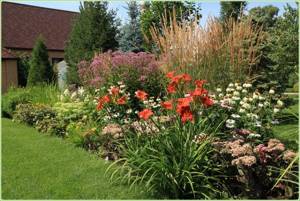
Daylily in a flower garden
Optimal disembarkation time
Daylilies can be planted in a personal plot or garden throughout the warm season. However, it is spring planting that is considered the most successful. Seedlings quickly take root and flourish in flowering. The material can be stored for a month - just sprinkle the roots with a mixture of sand and peat. The leaf blades are cut in half.
You can also plant daylilies in the fall of 2021. But it is advisable to do this before the onset of severe cold. Otherwise, they simply will not have time to take root. Before winter, seedlings are covered with earth and mulched with leaves. Experienced gardeners believe that May and August are the two most favorable months for planting.
Soil preparation
Soil selection plays an important role in preparing for planting. On the one hand, flowering of daylilies is quite possible on any type of soil. But on the other hand, to achieve maximum results, growing daylilies must be accompanied by suitable conditions.
According to experts, the best choice would be fertile loam with drainage . Clay soil is diluted with sand and compost. Take care to keep the area free of excessive moisture. This is especially true for areas located in lowlands. There are two options: arranging drainage for daylilies at your own dacha or planting them on a raised bed.
Planting in open ground - main nuances
Before planting, each seedling is carefully inspected. Weak and damaged roots are removed, and the cut site is treated with a fungicide solution. Dried roots are moistened in a growth stimulator.
Further actions are performed in the following sequence:
- The area is being dug up. If necessary, fertilizers are applied (compost, rotted manure). For depleted soil, we can recommend a mixture of humus with peat (1 bucket), 30 g of phosphorus and the same amount of potassium.
- Depressions are made according to the size of the roots and the rhizome is distributed.
- Sprinkle and compact, water with a small amount of water. When planting daylilies, regardless of the variety, the root collar is deepened by 3 centimeters.
- In a flower bed with daylily flowers, the distance between plants should be 70 centimeters.
In order for the hybrid daylily to receive a sufficient amount of moisture, it is necessary to reduce its evaporation. The soil is mulched; pine needles and tree bark are suitable. This is how daylilies are transplanted not only in spring, but also in autumn. Maintenance is minimal: water on time.
Tips for care and planting (video)
Hybrid daylily outstanding: planting
The choice of planting location for a daylily hybrid depends entirely on the characteristics of the plant. Namely: from the choice of a tall or short species.
If the varieties of such plants are correctly combined, then the flowerbed will delight you throughout the entire season, since such a combination will create a lush and beautiful landscape.
In order to plant such a flower, you need to prepare a hole separately for each plant. When preparing a place for planting, do not forget that this flower will bloom in this place for more than one year. At the moment you are planting one flower sprout, but after 3 years, it will become a spreading fluffy bush with a girth of 75 cm.
If the soil is fertile and everything grows well on it, then to plant daylilies it is necessary to do the following work.
Namely:
- Dig a hole;
- And plant a flower.
If you doubt the quality of the land, then in the fall you need to add peat, sand, humus and fertilizers. When planting the plant, do not go deeper than 3 cm.
Watering, fertilizing
Without regular watering, yellow or pink daylilies may drop their buds or turn yellow. Plants are watered especially abundantly during drought, but this is done early in the morning or late in the evening. The soil should be saturated with moisture to at least 20 centimeters. Shallow sprinkling will also be a good solution. Watering is reduced if the summer is rainy.
Daylilies are fed in the second year after planting. Complex fertilizers with a moderate amount of nitrogen are recommended. You can feed 1 time in the spring, 2 more times in the summer. Potassium-phosphorus fertilizing will help strengthen the daylily flower before wintering.
Preparing for winter
Different types of natural and hybrid daylilies react differently to severe frosts. But in general, they all have high frost resistance. But if it’s a snowless winter, the likelihood of frostbite is high. In such cases, it is recommended to cover the plant with spruce branches or pine needles. When the snow begins to melt, the protective cover is removed.
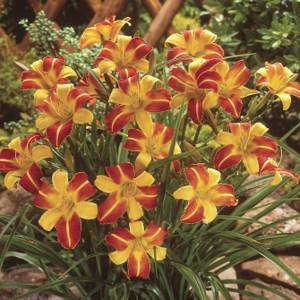
If they promise a winter with little snow, then it is better to cover the daylily
About reproduction
All daylilies for further planting and care in open ground are propagated vegetatively. For example, by rooting a rosette of a leaf, dividing. Daylily seeds are rarely planted. This is due to the fact that seed propagation leads to loss of differences. The only exception will be seeds purchased from a reliable manufacturer.
The culture is quite unpretentious, so the transplantation process is easily tolerated. It is enough to remove the bush from the ground and use a knife to divide the planting material into shoots with rhizomes.
Cultivation from seeds is carried out at the end of winter. They are soaked before planting. After pipping, they are planted in cups with a universal type of soil. Be sure to make drainage holes and feed them with fertilizers. The transplant is done at the end of May.
